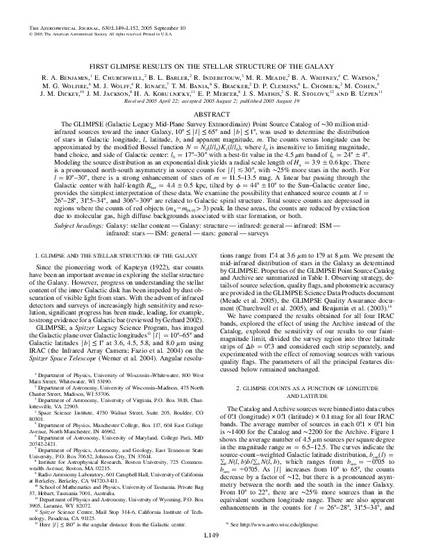
Article
First GLIMPSE Results on the Stellar Structure of the Galaxy.
The Astrophysical Journal
(2005)
Abstract
The GLIMPSE (Galactic Legacy Mid-Plane Survey Extraordinaire) Point Source Catalog of ~ 30 million mid-infrared sources towards the inner Galaxy, 10 < |l| < 65 degrees and |b| < 1 degree, was used to determine the distribution of stars in Galactic longitude, latitude, and apparent magnitude. The counts versus longitude can be approximated by the modified Bessel function N=N_0*(l/l_0)*K_1(l/l_0), where l_0 is insensitive to limiting magnitude, band choice, and side of Galactic center: l_0= 17-30 degrees with a best fit value in the the 4.5 micron band of l_0=24 +/- 4 degrees. Modeling the source distribution as an exponential disk yields a radial scale length of H= 3.9 +/- 0.6 kpc. There is a pronounced north-south asymmetry in source counts for |l| < 30 degrees, with ~ 25% more stars in the north. For l=10-30 degrees, there is a strong enhancement of stars of m= 11.5-13.5 mag. A linear bar passing through the Galactic center with half-length R_bar=4.4 +/- 0.5 kpc, tilted by phi=44 +/- 10 degrees to the Sun-Galactic Center line, provides the simplest interpretation of this data. We examine the possibility that enhanced source counts at l=26-28 degrees, 31.5-34 degrees, and 306-309 degrees are related to Galactic spiral structure. Total source counts are depressed in regions where the counts of red objects (m_K-m_[8.0] >3) peak. In these areas, the counts are reduced by extinction due to molecular gas and/or high diffuse backgrounds associated with star formation.
Keywords
- Stellar Structure,
- Galaxy
Disciplines
Publication Date
September 10, 2005
Citation Information
R. A. Benjamin, E. Churchwell, B. L. Babler, R. Indebetouw, et al.. "First GLIMPSE Results on the Stellar Structure of the Galaxy." The Astrophysical Journal Vol. 630 (2005) ISSN: 2041-8205 Available at: http://works.bepress.com/richard_ignace/10/
